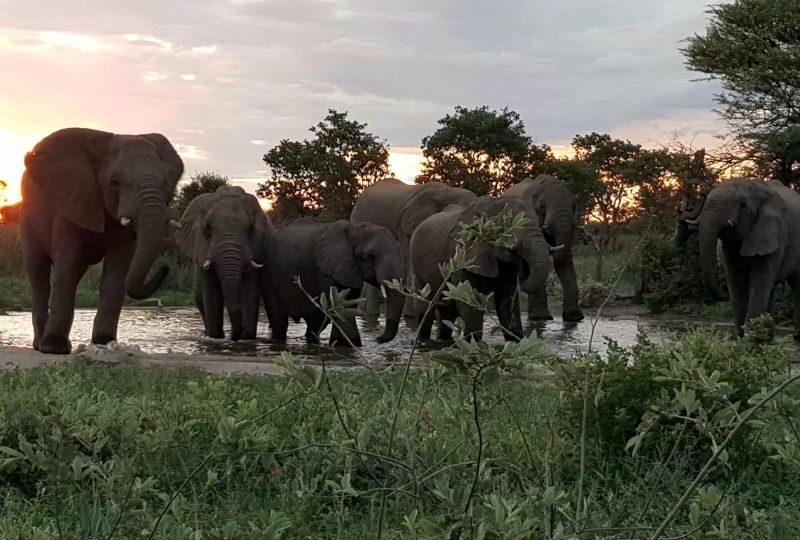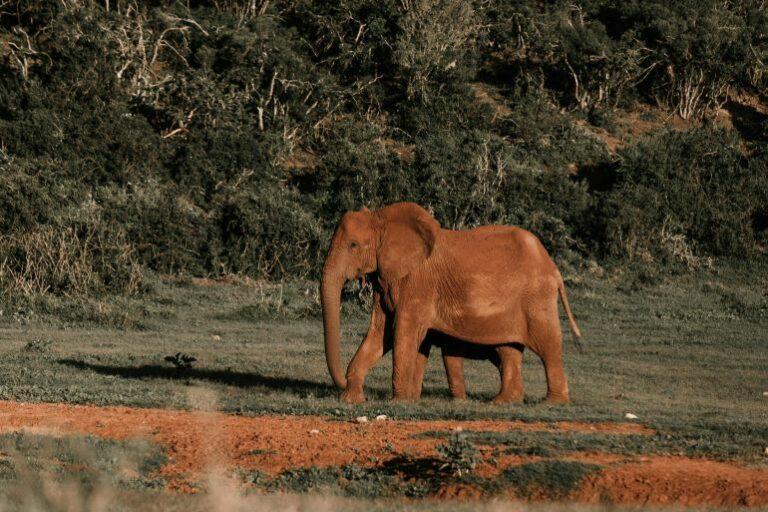Elephant hunts in Africa are seen as some of the most dangerous, exhilarating, and adrenaline-filled hunting safaris a hunter can experience. But what about tuskless elephant hunts? Are elephant hunts in Africa purely about the ivory and the trophy, or is there more to it, and can tuskless elephant hunts measure up to the pure adrenaline and enjoyment of this notorious African big game hunting adventure?
[DYNAMIC-BLOGTABLEOFCONTENT]
The African Elephant
As a child, I thought that elephants were gentle giants that roamed through the forests and did no harm. They continued on their merry way, munching on surrounding vegetation before calmly walking off.
In Grade 11 or 12, we were given the setwork book “Kringe in die Bos” (Circles in the Forest) which made me consider that elephants were, in fact, more than just large trunked creatures found in forests. This book brought to life the soul of these animals, bringing to the fore the personalities, lives, and importance of elephants within an ecosystem and that, as the saying goes, all lives matter.
And it is this revelation that had at first, many years ago, me so vehemently opposed to hunting and all things hunting…before I understood the role hunting plays in conservation, and how hunting practices can be ethical and just.
Being born and bred in Africa, I am one of the fortunate individuals who can witness these amazing creatures close up. In fact, it was during a recent visit to a local National Park in the region, home to a huge resident elephant population that had me questioning elephants and how these tuskless elephants differ from the rest of the herd, and whether elephant hunts in Africa are purely just about the tusks.

Elephant Fast Facts
Elephants are the world’s largest land mammals, with Africa home to two of the three types of elephant species worldwide.
- The African Bush Elephant
Also known as the African savannah elephant, this mighty beast weighs up to 14,000 pounds and is native to sub-Saharan Africa, including Kenya, South Africa, Namibia, Uganda, Tanzania, Botswana, Zimbabwe, Zambia, and Angola.
- The African Forest Elephant
The African Forest elephant is native to West Africa and the Congo Basin, preferring humid, tropical forest habitats. This little elephant (if we can call it that!) is the smallest of the three living elephant species, reaching a height of 7,8 feet.
Elephants are gray and wrinkly in appearance, with callous skin. Most elephants have tusks, namely incisors that extend beyond their mouths to form what we call tusks. These are made of ivory and are used to assist in foraging for food, digging for water, and in their defense against predators, or fighting for dominance with other elephants.
Apart from its tusks, another of the elephant’s most incredible physical attributes is, of course, its large trunk. An elephant’s trunk is an extension of its upper lip and nose and is used for breathing, feeding, smelling, sensing, lifting, grasping, and even as protection. These amazing appendages contain more than 100,000 tendons and muscles that assist the elephant by grasping, moving, and contracting in various directions as required.
While the elephant may look calm, and relaxed and referred to as a “gentle giant,” things can quickly change with this member of Africa’s Big 5 and Dangerous 7 being quite capable of attacking and killing humans, should it feel that it or the herd is in danger.
Elephant Hunts in Africa
Elephant hunts in Africa are undertaken for a variety of reasons, both legally and illegally, resulting in the decline of their numbers.
Ivory
Despite the ivory trade being banned, African elephants are still being poached for their tusks. The ivory is utilized in various ways, such as for ornaments and jewellery.
Human-Wildlife Conflict
There is a rise in human-wildlife conflict. As the human population grows, so does its need for space for infrastructure and agriculture. This in turn leads to shrinking natural habitats and less food being available, which in turn then results in the elephants engaging in crop-raiding. This behavior can cause damage to crops and loss of income to the human owners, resulting in an evitable conflict situation.
Loss of Natural Habitat
As communities grow and thrive, undeveloped areas such as forests are now turned into areas targeted for infrastructural growth, or even agricultural lands, leading to the loss of natural habitat for elephants.
Why Are Some Elephants Tuskless?
A tuskless elephant is simply that – an elephant that doesn’t grow any tusks. Tusks are essentially overgrown teeth.
Tusks are teeth (incisors) that continue to grow and form an elephant’s tusks. Approximately a third of an elephant’s tusk is not visible, sitting in the mouth and jaw of the elephant, while the other two-thirds is the visible section of the ivory tusk.
Researchers at Princeton University in the US have identified the two genes that are associated with tooth development in mammals that play a major role in the tusklessness of Africa’s elephant population. One of these genes is linked to the X chromosome. Interestingly, it is lethal to males. Humans with a similar gene mutation also exhibit teeth defects.
While female elephants can continue with normal lives not having tusks, as per above, there aren’t any male tuskless elephants as this condition is lethal.
Where Do You Find Tuskless Elephant Populations in Africa?
Although tuskless elephants do occur naturally in savanna elephants, there are very large populations of tuskless elephants in Botswana, Zimbabwe, and Mozambique. The average percentage of tuskless elephants should be around 6% of females, whereas these destinations have much higher numbers
Some interesting facts show that before the war in Mozambique, around 18,5% of the female animals were tuskless. With elephants born during the 1990s and onwards, this percentage has risen to an amazing 33% being tuskless. During the way, elephants were hunted and poached for their tusks, resulting in fewer female elephants with tusks. Those female elephants that didn’t have tusks were largely spared, resulting in them passing on the gene to future generations. The result? A larger grouping of tuskless females that continued to breed and carry the gene.

Are Tuskless Elephant Hunts in Africa Worthwhile?
If you are interested in a hunting adventure targeting a member of the Big 5 and Dangerous 7, that is even more aggressive than a Cape buffalo, is stronger than a lion, and weighs more than a rhino, with a bad attitude and irritability to match then, yes, tuskless elephant hunts in Africa are ticking that box.
Tuskless elephants are definitely top of the list of dangerous game hunting in Africa! Firstly, tuskless elephants are seen as being more moody, aggressive, and dangerous, leading to a euphoric and challenging hunting adventure. Yes, you may not get the tusks, but the thrill and adrenaline of hunting what is seen as an even more dangerous hunting adversary than a Cape buffalo (and quite a bit bigger and stronger!) is well worth it.
When tuskless elephant hunting in Africa, be prepared for a highly aggressive, very protective animal that will have you hearing your own rapid heartbeat in your ears, as you desperately try to quell your raspy breathing and calm your shaking hands. Sounds like fun, doesn’t it?
Tuskless elephants are often sold at a discounted hunt, which is great for making that hard-earned money stretch for your African hunting trip. And while the US is allowing trophy hunting imports right now, this can change very swiftly.
Elephant Cows vs Elephant Bulls: Who’s the More Aggressive?
It is said that elephants are one of the most dangerous African big game species to target on an African hunt. Their strength and size become a major challenge for any hunter should an elephant feel threatened or in danger. And that’s just an elephant bull.
Add to this an elephant cow, who is protecting her young and you have a firecracker just ready to explode. Just like any mother will protect her young, so too will an elephant cow. The only difference is that most mothers don’t weigh around 6,000-8,000 pounds, are not as strong as an elephant, and also don’t have tusks to boot!
Many hunters report that an elephant cow is far more dangerous than a bull to hunt, due to their innate desire to protect their young against anything – and anyone.
When it comes to tuskless elephants, you have just upped the stakes tenfold. The lack of tucks, used to feed, forage, and defend themselves, is absent. This makes life more challenging for tuskless elephants making them (dare l say it?) even more grouchy and ill-tempered. And then a hunter makes the mistake of threatening an elephant or leading a tuskless elephant cow to believe that her baby is in danger….Mistake. BIG mistake. Someone will need to pay, and in the elephant’s mind, it is the hunter.
From the hunter’s viewpoint, this provides an exciting, jam-packed adrenaline elephant hunting adventure! Tuskless elephant cows are seen as more aggressive than a wounded Cape buffalo…the same Cape buffalo that is often referred to as “Africa’s Black Death” or “The Widow Maker!”
So, to answer the question at hand…cows versus bulls? The cows, most definitely the cows, and that answer should have dangerous game hunting enthusiasts smiling all the way to the bush!

What are the Methods for Tuskless Elephant Hunts in Africa?
Hunting elephants in Africa is a unique and challenging experience that requires careful preparation. The main method used for tuskless elephant hunting in Africa is through a tracker.
Trackers are used to find an elephant’s track and then continue to track it until the herd of elephants is found. These amazing individuals can read the trail of the elephants and contribute to a successful hunt by assisting in the interpretation of the signs the animal has left behind, to find it.
Elephant hunting adventures will see you walking and stalking the elephants for many miles or hours until you are close enough to the herd where the tracker’s job is complete, and the time has come to exercise precision shot placement.
If you are unsure of the shot, don’t take it. Elephants, especially tuskless cows, are not to be messed with. Check out our section on shot placement for elephants for additional information.

How to Prepare for a Tuskless Elephant Hunt
- Elephant hunting is not for the faint-hearted, or unfit. This African hunt will see you walking miles per day as the elephants are tracked. Ensure that your fitness levels are up!
- Make sure that you are feeling well, both physically AND mentally. A great deal of game hunting safaris is having your head in the game.
- Research as much as you can about elephant hunts and dangerous game hunting, the more you know, the better prepared you are.
- Research shot placement and the elephant’s anatomy to best plan your game hunting safari.
- Know your weapon of choice for your African hunt and be well-prepared and familiar with it.
- Update your will. Is it a bit dramatic? Maybe, maybe not, but rather safe than sorry. This is, after all, a dangerous game hunting adventure.
- You will be spending hours in the African sun. Pack a decent hat and sunscreen.
Tusks or Tuskless….That is the Question!
While elephant hunts in Africa give hunters the option of both tusked and tuskless hunting adventures, the choice is yours. While a tusk may be a great memento of an exciting and memorable African big game hunting adventure, the real hunting safari begins with one tuskless elephant, feeling angry, aggressive…and territorial and the hunter who brought her down. Is that hunter going to be you?
Author: B. Hershensohnn
